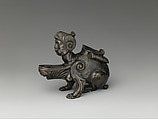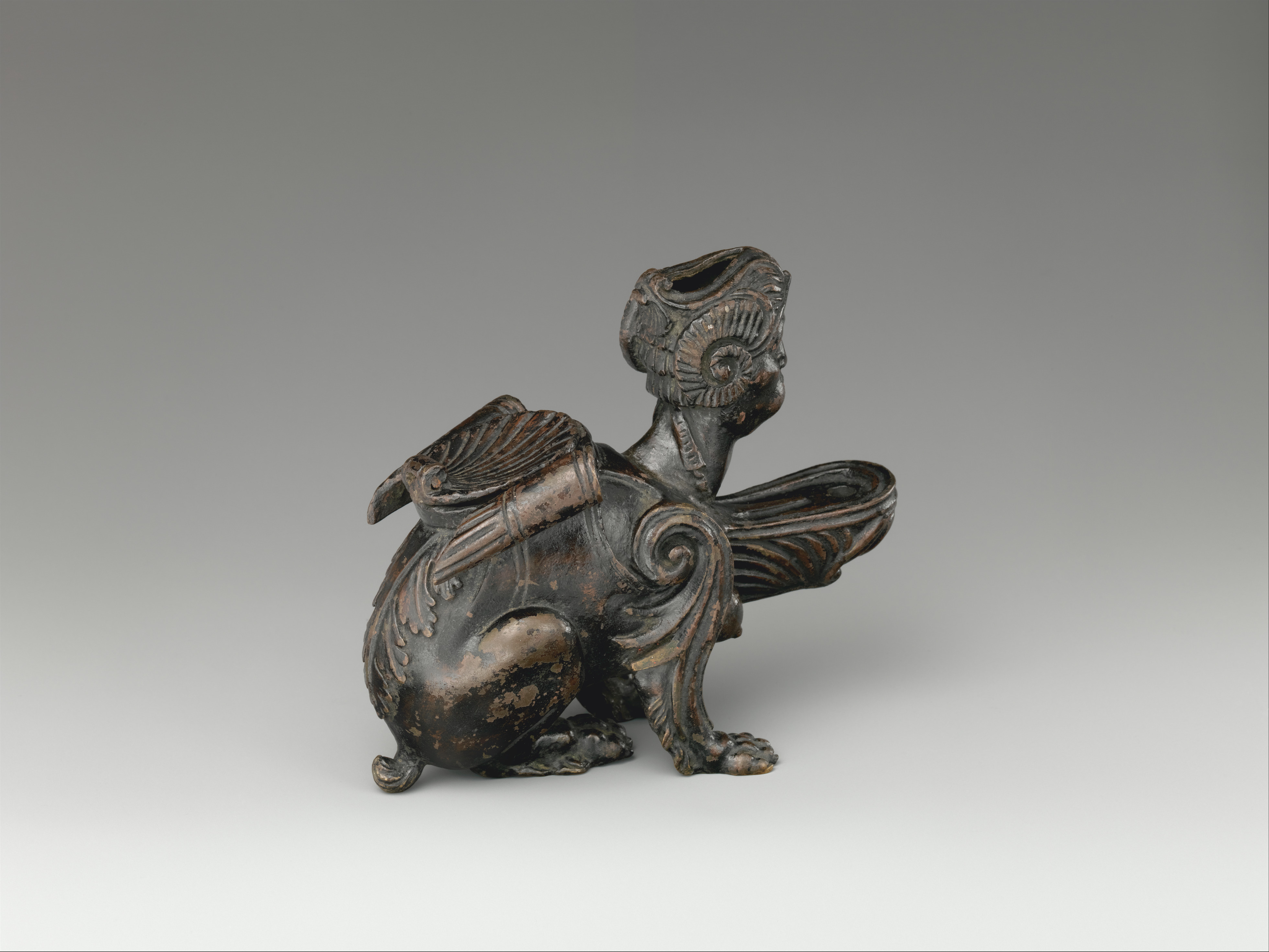Oil Lamp in the Form of a Sphinx
Probably workshop of Andrea Briosco, called Riccio Italian
Not on view
This small oil lamp is in the form of a sphinx, an ancient Egyptian and Greek mythological creature prized for its intelligence and wisdom. The crouching hybrid figure wears a helmet adorned with ram’s horns and rests on three bear claws. Tastefully arrayed decorative patterns, largely modeled in the wax, include spiraling volutes at its shoulders and a foliate pattern on its rear. On its back, flanked by two scrolls, is a hinged lid in the design of a shell that opens to hold oil. A smaller hole on the figure’s head could have contained ink, sand, or a second wick.[1] Though the sphinx has prominent breasts, its face is genderless, with strong features and puffed cheeks in a state of perpetually attempting, however unsuccessfully, to extinguish (or fan) a flame, which would have emerged from the basin protruding below. Despite the absence of a wick pan, the lamp appears to be fully functional.
The Met’s bronze is a cast of a popular model that has been associated with the Paduan sculptor Riccio and his workshop as well as unrelated subsequent production over the following centuries. Riccio had included sphinxes in his designs for the Paschal Candelabrum in the Basilica di Sant’Antonio, Padua (p. 00, fig. 13c), and on the Della Torre tomb in San Fermo Maggiore, Verona. It is thought that such motifs migrated from these syncretistic religious monuments that combine pagan and Christian elements to the utilitarian objects in demand by Paduan collectors during this period, which included oil lamps, incense burners, and inkwells.
The present model was first published with an attribution to Riccio by Wilhelm von Bode, who illustrated the Bargello’s version.[2] In his monumental 1927 monograph on the artist, Leo Planiscig upheld the attribution and included images of two other examples.[3] In his 1982 study clarifying various issues posed by Planiscig’s expansive monograph, Anthony Radcliffe laid out three different groupings for the various lamps in the form of a sphinx.[4] Our bronze falls into the first, and most prevalent group, of which Radcliffe considered finest an example formerly in the Adda collection. In 2007, Alison Luchs and Dylan Smith published a high-quality version in the Robert H. Smith collection and listed many of the more than two dozen known casts.[5] Other notable examples, either for their provenance or quality, include those in the Morgan Library & Museum in New York, the Art Institute of Chicago, the Landesmuseum Zurich, and the Louvre.[6]
Though these lamps have long been associated with Riccio, scholars have recognized that the sculptor was unlikely to have been involved directly with their design or production, and that their popularity meant they were produced over the next two centuries long after his workshop had ceased being active. In one example of their eighteenth-century renown, the French monk Bernard de Montfaucon included illustrations of multiple versions of the lamps, considered antiquities, in his L’antiquité expliquée et représentée en figures (fig. 22a). In its intricately modeled details, and its closeness to the Adda and Smith examples, The Met’s bronze should be considered one of the best iterations, though still unlikely to have been made in Riccio’s workshop.[7]
Following the initial discussion by Radcliffe, Jeremy Warren has proposed a connection between these oil lamps and the still mysterious figure of Desiderio da Firenze, one of Riccio’s successors in Padua.[8] This connection is based largely on similarities between Desiderio’s Voting Urn for the commune of Padua (p. 00, figs. 21a–b), work on which began in 1532, and two firedogs attributed to him in the V&A.[9] This hypothesis helps extend the date of the production of these lamps beyond Riccio’s immediate orbit but remains speculative.
It is important to note that our bronze is one of the first attributed to Riccio to enter an American museum collection. Curator W. R. Valentiner purchased it in 1911 from the Frankfurt-based dealers J. & S. Goldschmidt for the extremely high price of $3,500, along with a second oil lamp for $2,000 (the latter deaccessioned in 1986 after an identical cast entered through the Untermyer bequest [see cat. 23]). Valentiner published these two oil lamps in the museum’s Bulletin, along with the Boy with a Barrel (cat. A<11.5.3>).[10] One of the first studies of Riccio for American audiences, Valentiner’s short article was largely based on his mentor Bode’s studies.
In fact, the entire acquisition process shows the influence of Bode on Valentiner and the formation of The Met’s collection of bronzes. Both oil lamps Valentiner acquired in 1911 had previously been in the Berlin collection of Adolf von Beckerath, for whom Bode had consulted. In pursuing these two bronzes, Valentiner explicitly rehearsed the same pairing Bode illustrated in his study of Italian bronze statuettes (fig. 22b). This echoing is made clear in the curator’s letter to The Met director justifying the purchase:
"The two bronze lamps are by Riccio, the greatest bronze sculptor of Northern Italy. His importance as a sculptor is the same as that of Mantegna among the painters. They are two of his best pieces, as has been shown by Bode in his book on Italian Statuettes, in which he reproduces two similar ones in the Bargello in Florence. These bronzes which are offered to us are in no way inferior to those in the Bargello. They came from the collection of Beckerath, who is well known in Berlin as the great collector of works in the Renaissance. He sold all of his bronzes, and these have always been considered as the best in his collection."[11]
-JF
Footnotes
(For key to shortened references see bibliography in Allen, Italian Renaissance and Baroque Bronzes in The Metropolitan Museum of Art. NY: The Metropolitan Museum of Art, 2022.)
1. As suggested by Luchs and Smith in Smith Collection 2007, p. 16, for the example in the Robert H. Smith collection.
2. Bode 1907–12, vol. 1, p. 28, pl. XLVI.
3. Planiscig 1927, pp. 251, 252, 482.
4. Radcliffe 1982, pp. 418, 423–24.
5. See Smith Collection 2007, p. 18 n. 18.
6. I am grateful to Jennifer Tonkovich and Daria Rose Foner of the Morgan for generously sharing research on the bronzes in their collection during a study day held at the Morgan in spring 2019 as well as subsequently in email correspondence.
7. Richard Stone suggests the piece is not closely connected to Riccio’s immediate circle of imitators, and most likely dates to a generation after his death, if not later. He identified the alloy as a brass and notes the use of transfixing core pins plugged with drawn wire. He also questions why there are two filling pots, one on the back and a smaller, “pseudo-functional” one on the top of the head. R. Stone/TR, November 9, 2011.
8. Warren 2001a, pp. 93–97.
9. V&A, A.89-1910, A.90-1910.
10. Valentiner 1911.
11. Letter from Valentiner to Robinson, dated February 17, 1911, MMA Archives.
Due to rights restrictions, this image cannot be enlarged, viewed at full screen, or downloaded.
This artwork is meant to be viewed from right to left. Scroll left to view more.



